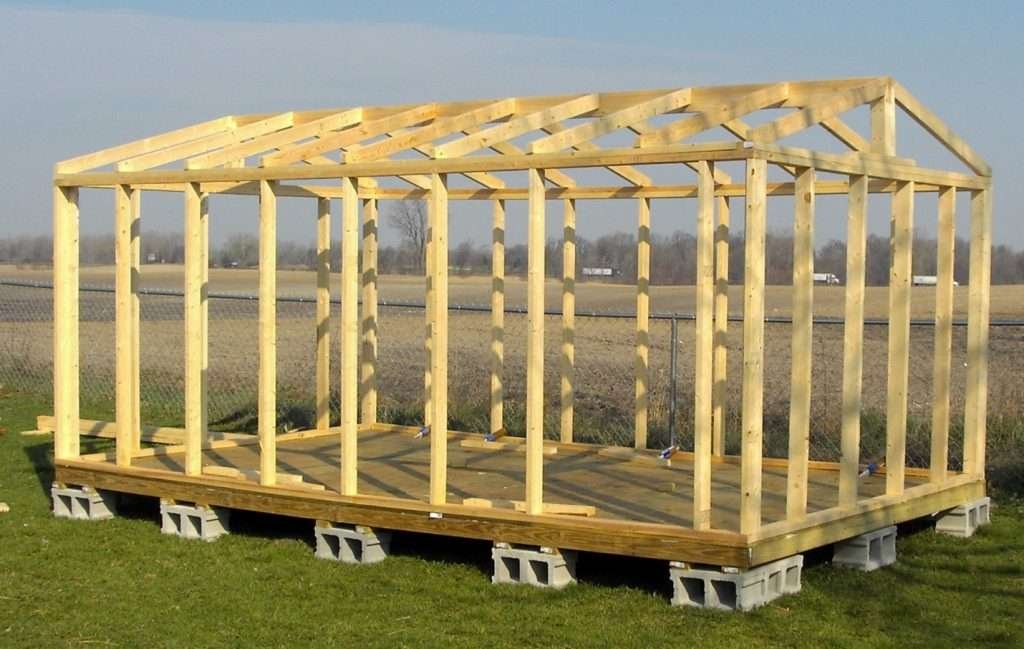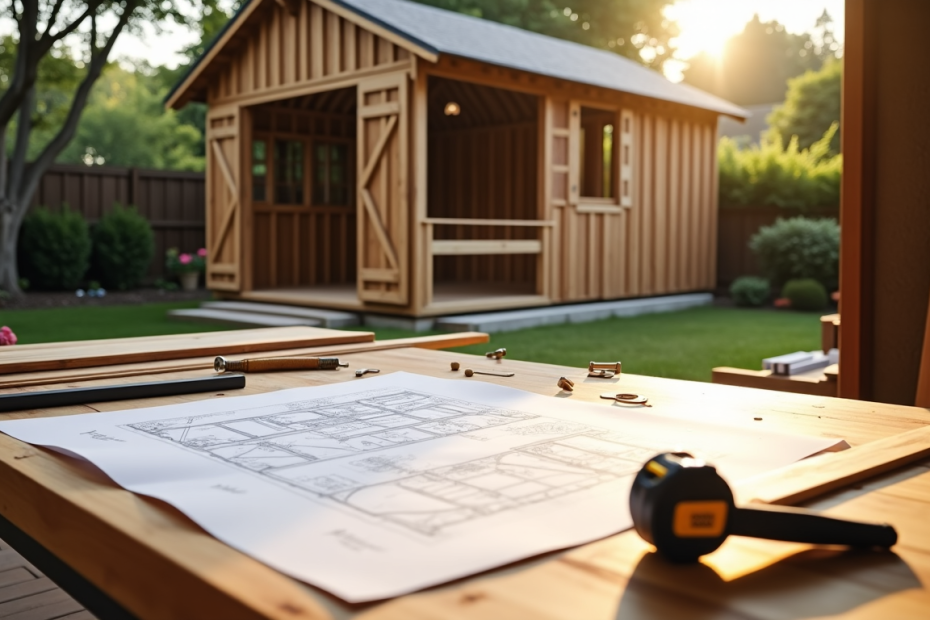A backyard shed project looks simple at first glance. Yet many experienced DIYers hit roadblocks midway through construction when they lack proper shed blueprints.
Our team has reviewed countless shed building plans and DIY shed blueprints. This unmatched experience taught us that perfect shed blueprints go beyond attractive designs. The right plan must align with your skill level, specific needs, and local requirements.
This piece will guide you through the essential elements to think about when selecting blueprints for your shed. You’ll learn how to evaluate design complexity, understand simple requirements, and navigate building codes. These insights will help you make smart choices that lead your project to success.
Understanding Your Shed Requirements
A successful shed blueprint starts with a clear picture of what you need. Let’s explore what you should think about before picking your perfect shed building plans.
Assessing storage needs and purpose
You’ll need to review what you plan to store in your shed. Our experience shows homeowners often underestimate their storage needs at first. Here’s what you should think about:
- Garden equipment and tools
- Seasonal decorations and furniture
- Workshop space requirements
- Recreational equipment
- Future storage growth
Your shed building blueprints should include 20-30% more space than you currently need to fit future items comfortably. The average cost per square foot ranges from $20 to $175, so getting the size right from the start is significant.
Evaluating available space and location
The right location matters just as much as the DIY shed blueprints. Your shed’s placement needs to balance easy access with practical needs. You need a level spot with good drainage and enough room on all sides. A minimum of 2 feet of clearance around your shed works best for maintenance and accessibility.
Sun exposure, utility access, and how often you’ll use the shed should shape your decision. A workshop or frequently used storage space works better closer to your house for easy access.
Determining budget constraints
Budget planning varies substantially based on your needs. The average shed construction costs between $1,767 to $9,567, depending on size and complexity. Here’s what affects your budget:
Materials and labor make up most of your expenses. Professional help costs between $50 to $100 per hour for skilled labor. Permit fees typically run from $50 to $200.
A smart approach includes a 10-15% buffer in your budget for unexpected costs. It’s worth mentioning that pre-built sheds might cost more upfront but can save time and prevent construction challenges compared to starting from scratch with simple shed blueprints.

Navigating Local Building Codes
Let’s talk about one of the most significant aspects of shed construction before you start working with your blueprints: local building codes. Our experience helping homeowners with shed projects shows that understanding these regulations early can save you substantial time and money.
Permit requirements and restrictions
Permit requirements vary substantially by location. All but one of these sheds under 120 square feet don’t need a permit, but you should know about some important exceptions. These factors usually trigger permit requirements:
- Sheds larger than 120 square feet
- Structures with electrical or plumbing installations
- Buildings used for purposes beyond storage
- Permanent foundations
- Commercial use structures
Size and height limitations
Size and height restrictions often create problems with shed building plans. Most areas limit shed height to 20 feet for single-story structures. The common size thresholds are:
- Under 120 sq ft: Often permit-exempt
- 120-200 sq ft: Varies by location
- Over 200 sq ft: Usually requires permits
Setback regulations and zoning laws
Setback requirements matter just as much as size limitations in DIY shed blueprints. Your shed needs to be 5 to 10 feet away from property lines, fences, or other structures in most areas.
Some areas have extra rules to consider:
- Historic districts often have specific construction plans
- Some locations require specific foundation types to resist wind
- Corner lots may have special setback requirements
- Utility easements must remain clear
Check with your local building department before selecting shed building plans. You might need extra permits to work on electrical, plumbing, or roofing. Building without proper permits can lead to fines or the removal of your structure.
Evaluating Blueprint Blueprint Complexity Levels

Choosing the right complexity level for your shed blueprints determines the success or failure of your project. Our analysis of many shed building plans helps you match your skill level with available resources.
Beginner-friendly vs advanced designs
Our experience with shed building blueprints reveals three complexity levels:
- Simple designs: These work best for first-time builders with rectangular layouts
- Intermediate plans: These add windows or simple storage solutions
- Advanced blueprints: These feature complex elements like dormers or custom storage systems
Shed kits work best for beginners because they include detailed manufacturer instructions and pre-cut pieces. You can assemble these pre-fabricated options in one to three days based on your construction knowledge.
Required construction skills
DIY shed blueprints need different skill levels. Beginners should look for plans that offer:
- Clear step-by-step instructions
- Material lists with exact measurements
- Multiple construction angles
- Expert tips for each section
Simple carpentry skills work fine for basic designs, but larger projects need extra help. Most experienced builders need another person to complete the job efficiently.
Time and resource commitments
Our field experience shows project timelines change with design complexity. Simple storage sheds take several weeks, while pre-fabricated options need just four hours.
The right tools matter before you start. Missing equipment can substantially increase your upfront costs. Quality blueprints must include:
- Full materials list with hardware details
- Cutting lists with exact measurements
- 2D and 3D views for visualization
- Feature-specific dimensions
New builders should start with beginner-friendly designs. These simpler plans save time and money, especially since complex projects involve steeper learning curves.
Analyzing Material Specifications
Material specifications can make or break your shed building project’s success. Let’s get into the vital components that quality shed blueprints should address.
Foundation options and requirements
Our experience with DIY shed blueprints shows that foundation choice affects long-term stability. Concrete foundations are the most popular choice and need a minimum thickness of 4 inches for good support. Gravel beneath the foundation gives better drainage and stability. It stops water buildup and resists compression better than dirt.
Framing and structural considerations
Proper framing specs are vital for structural integrity. Most shed plans set wall studs 16 inches apart, though some builders use 24-inch spacing. Here’s what works best for optimal strength:
- Double 2x4s for top plates to boost wall stability
- Headers with plywood reinforcement between boards
- Corner framing with proper pocket space for nailing surfaces
- Reinforced 2x4s on walls for added strength
Header specifications need special attention, especially above doors and windows. Good plans should show details for multiple connected 2x4s with plywood between boards to prevent bowing.
Roofing and siding choices
Siding selection affects both durability and maintenance needs. Modern shed plans often feature these popular options:
Durable and weather-resistant siding materials work best. Quality siding should overlap and protect all seams from wind-driven moisture. Good blueprints will include proper ventilation and moisture barrier details.
Architectural shingles are a great roofing choice with their 30-year warranty. Your blueprint’s roof pitch should show a 4/12 ratio – rising four inches for every twelve inches of horizontal run. This design ensures good water drainage and keeps structural integrity intact.
Years of reviewing shed plans teach us that material specs must match your local climate. Pick materials that handle your area’s weather challenges well, from heavy snow loads to intense sun or frequent rain.
Comparing Blueprint Features
Our review of shed building plans shows that your blueprint’s features can affect how you use your shed daily. Let’s get into the elements that make a shed both practical and efficient.
Door and window placement options
Door placement plays a vital role in accessibility and space usage. Standard shed doors range from 78″ to 86″ in height, while width varies between 25″ to 36″ inches. Your shed will work better if you think over these specifications:
- Double doors on the gable end to fit large equipment
- Side entry door that makes access easy
- Minimum 36″ width if you store riding mowers
- Extra clearance for ramps on elevated sheds
Placing doors on the gable side gives you more interior wall storage space. Windows should have enough space underneath to add workbenches and shelving.
Ventilation and lighting considerations
Quality shed plans need proper ventilation to prevent moisture buildup and keep air fresh. Your plans should include several ventilation options.
Natural light works best with windows placed strategically. High-wall windows at eaves level let in light without taking up valuable wall space. LED strip lights and solar-powered options give you economical lighting solutions.
Your ventilation system needs to handle summer heat and winter moisture. The best setup includes:
- Ridge vents that help air move
- Gable vents for cross-ventilation
- Soffit vents that let air in
Storage organization possibilities
Storage organization starts with your original design. These features help you use space better:
- Loft space above stores seasonal items
- Wall-mounted racks hold long-handled tools
- Pegboard sections keep frequently used items handy
- Adjustable shelving systems adapt to your needs
Workbench areas work best when placed under tool storage. Modern shed plans often add ceiling storage options – perfect for items you don’t use often.
Look at exterior storage options in your shed plans. Good blueprints show you how to mount tools outside and add extra storage. Using both interior and exterior storage can double your space while keeping everyday items within reach.
Conclusion
Your perfect backyard shed project starts with the right blueprints. Our exceptional experience with shed construction shows how proper planning and blueprint selection can make the difference between a frustrating build and a soaring win.
Your chosen shed blueprints should match your skill level, local requirements, and specific needs. Quality shed plans must provide clear material specifications, detailed construction steps, and smart storage solutions. Extra time spent evaluating these factors upfront helps avoid mistakes that can get pricey and will give a shed that serves its purpose for years.
The planning phase needs your complete attention. Think over everything we’ve covered – from permit requirements to ventilation systems – before you start construction. A well-planned shed project with appropriate blueprints will reward you with a sturdy, functional structure that improves your property’s value while meeting your storage and workspace needs.
